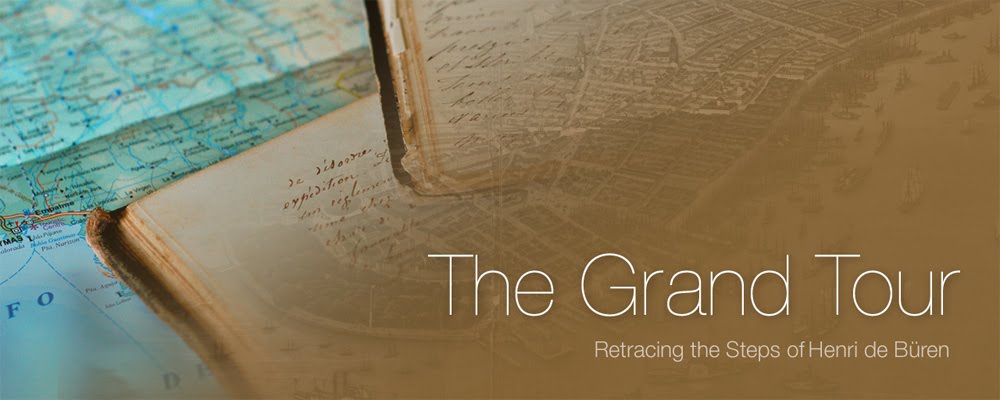The most recent discovery is about fellow Swiss Eugène Louis Frédéric de Freudenreich Falconnet (1832-1887). He was the son of Béat Frédéric de Freudenreich (1802-1872) and Eugenie Marthe de Palézieux Falconnet. He was born in the Château of Bremgarten in Bern and would leave for the Americas in 1849. He would spend a number of years in Mexico with his uncle, François de Palézieux Falconnet, the agent for the Committee of Mexican Bond holders with whom Henri stayed while in Mexico. Henri does not make mention of Eugène so they probably never met. Given the fact that Eugène was born a de Freudenriech it also makes him a cousin to Henri's second wife Natalie de Freudenreich.



de Freudenreich arms from the Catherdral in Bern

Château de Bremgarten where Eugène was born. © Christoph Hurni
After Mexico, Eugène who was an engineer, would settle in Tennessee, work for the railroad and later fight for the South during the Civil War. I find this all fascinating because until recently I was unaware of Swiss emigrants fighting for the Conferderacy.
The following passage on Eugène comes from Civil War Tales of the Tennessee Valley By William Lindsey McDonald
Major Eugene Falconnet is best remembered in Florence as the Confederate officer who was married to a local nurse in a wedding which occurred behind enemy lines, then spiriting her away to safety in a canoe. This daring adventure occurred at a time when Falconnet was being watched by the Federal authorities. As commanding officer of four cavalry companies, he was the "eye and ears", for Confederate Brigadier General Phillip D. Roddey, in Middle Tennessee and North Alabama.
Major Eugene Louis Frederic de Freudenreich Falconnet was born in 1832 at his ancestral home, Chateau Bremgarten in Bern, Switzerland. According to stories as remembered in Florence, the Falconnets had royal connections in that country. About 1849 he arrived in Mexico and became involved with the construction of a railroad. By 1852 he was in West Tennessee; nine years later Falconnet was in Nashville as Chief Engineer for the Nashville and Northwestern Railroad. Upon arrival in America he shortened his name to Eugene Frederic Falconnet.
At the outbreak of the Civil War, Falconnet enlisted in the First Regiment, Tennessee Volunteer Artillery. Always ambitious, he was granted permission as a private to organize an artillery company, at which time he became its commanding officer. In April 1862 his company became part of the artillery which Brigadier General Daniel Ruggles fought against General Benjamin M. Prentiss in the Hornet's Nest at Shiloh. Seven months later Falconnet was assigned as a major to the 14th Alabama Partisan Rangers, known as Malone's Alabama Cavalry. This regiment performed brilliantly under General "Fighting" Joe Wheeler in Alabama and Tennessee. In the fall of 1863, when Malone's Cavalry moved eastward with the Army of Tennessee, Falconnet was attached to Brigadier General Roddey, with his headquarters usually at Pulaski or Decatur, It was at this time that Major Eugene Falconnet was married to the nineteen-year-old Ann America Burtwell of Florence.
In late 1864 with Hood's Army in Tennessee, Falconnet was cited by General H. D. Clayton for gallantry in action. With less than 100 men, Major Falconnet successfully drove off a Federal cavalry force of "more than, twenty times his number." Soon after the war, the Falconnets buried their infant son, Hunter, in the family cemetery overlooking today's Industrial Paris Road and Cox Creek Parkway in Florence. They then moved to Nashville where he resumed his work with the railroads, He was also credited with the invention of several new processes of metallurgy and was one of the first to propose making steel in an ordinary blast furnace by passing a current of electricity through the molten metal. In 1881 and 1886 he was granted patents in six countries, including the United States, for his proposed air ship. This was fifteen years prior to Count Zeppelien's first air flight in Germany. Sadly, Major Falconnet was never able to arrange for the financing of his inventions.
Disappointed, this brilliant and gifted Civil War veteran died in October, 1887, and was buried beside his wife in the Mt. Olivet Cemetery at Nashville. He bequeathed his weapons to his son, expressing regret for having served in the war. In a final message to his children he wrote; "I have tried to behave with becoming modesty... I have left my mark in Tennessee and have largely contributed to the development of this country."

No comments:
Post a Comment